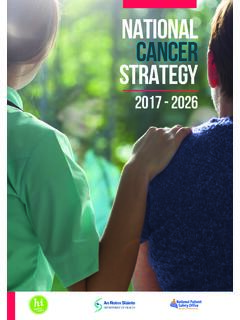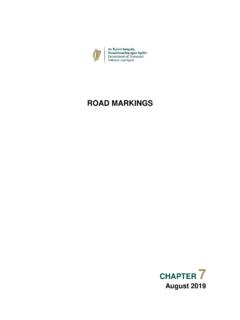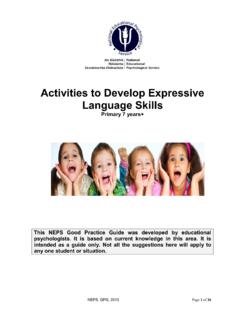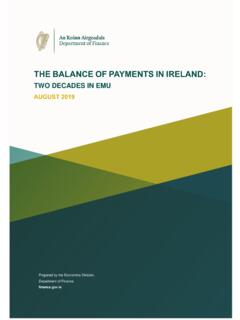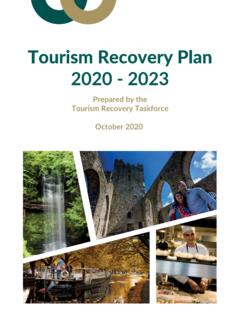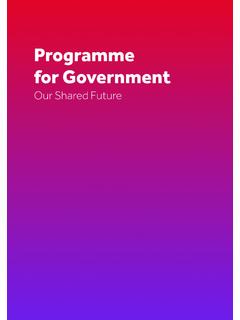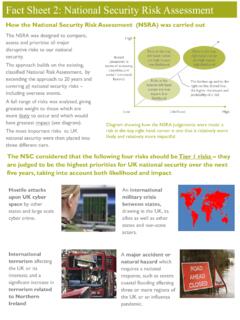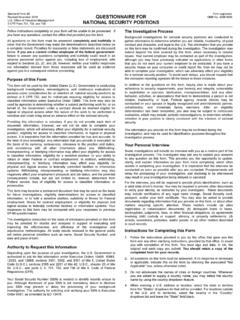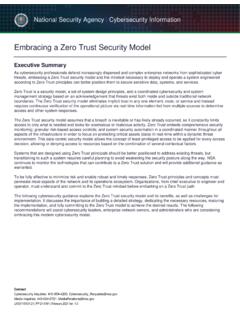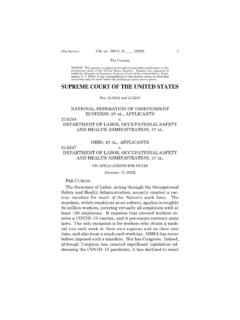Transcription of NATIONAL STRATEGY ON CHILDREN AND YOUNG …
1 NATIONAL STRATEGY ON. CHILDREN AND YOUNG PEOPLE'S. PARTICIPATION IN decision -MAKING. 2015 2020. NATIONAL STRATEGY ON. CHILDREN AND YOUNG PEOPLE'S. PARTICIPATION IN decision -MAKING. 2015 2020. Department of C. hildren and Youth Affairs June 2015. This STRATEGY was developed by the Citizen Participation Unit of the Department of CHILDREN and Youth Affairs. This report should be cited as follows: Department of CHILDREN and Youth Affairs (2015) NATIONAL STRATEGY on CHILDREN and YOUNG People's Participation in decision -making, 2015 2020. Dublin: Government Publications. Available at: Copyright Minister for CHILDREN and Youth Affairs, 2015. Department of CHILDREN and Youth Affairs 43-49 Mespil Road Dublin 4. Tel: +353 (0)1 647 3000. Fax: +353 (0)1 667 0826. E-mail: Web: Published by Government Publications ISBN 978-1-4064-2874-2. The Department of CHILDREN and Youth Affairs should be acknowledged in all references to this publication.
2 For rights of translation or reproduction, please contact the Department of CHILDREN and Youth Affairs. Contents Foreword by Minister v Introduction 1. Goal, focus and objectives of this STRATEGY 3. Structure of document 4. 1. Background and Rationale for the participation of CHILDREN and YOUNG people in decision -making 5. Background 6. Rationale 7. Process of development of the STRATEGY 8. 2. STRATEGY Objectives 11. Participation in decision -making in the everyday lives of CHILDREN and YOUNG people 12. Creating a supportive environment for participation 15. 3. Definition, Model and Principles of CHILDREN and YOUNG people's participation in decision -making 19. Defining participation 20. Lundy's Model of Participation 21. Voice Model Checklist 22. Principles of Participation 23. 4. Supporting Implementation 25. Legal supports 26. Policy supports 28. Infrastructural supports 29. 5. Action Plan 39.
3 References 55. Appendices Appendix 1: Government departments and agencies with commitments in Action Plan for NATIONAL STRATEGY on CHILDREN and YOUNG People's Participation in decision -making, 2015-2020 64. Appendix 2: Examples of DCYA dialogues and consultations with CHILDREN and YOUNG people 65. Appendix 3: Case histories illustrating effective participative processes 66. FOREWORD BY MINISTER. I am pleased to publish the Government's first NATIONAL STRATEGY on CHILDREN and YOUNG People's Participation in decision -making, 2015-2020. My Department is strongly committed to the participation of CHILDREN and YOUNG people in decision -making. We are proud to be the first country in Europe to develop a NATIONAL STRATEGY on CHILDREN and YOUNG People's Participation in decision -making. The STRATEGY builds on the developing infrastructure for CHILDREN 's participation established by my Department and other organisations since the publication of the NATIONAL CHILDREN 's STRATEGY in 2000.
4 The goal of this STRATEGY is to ensure that CHILDREN and YOUNG people have a voice in their individual and collective everyday lives across the five NATIONAL outcome areas set out in Better Outcomes, Brighter Futures: The NATIONAL Policy Framework for CHILDREN and YOUNG People, 2014-2020, namely: to be active and healthy; to be achieving in all areas of learning and development; to be safe and protected from harm; to enjoy economic security and opportunity; and to be connected, respected and contributing. The STRATEGY focuses on the everyday lives of CHILDREN and YOUNG people and the places and spaces in which they are entitled to have a voice in decisions that affect their lives, including in community, education, health and well-being, and legal settings. The STRATEGY is primarily aimed at CHILDREN and YOUNG people under the age of 18, but also embraces the voice of YOUNG people in the transition to adulthood.
5 It is guided and influenced by the United Nations Convention on the Rights of the Child and the EU Charter of Fundamental Rights. Giving CHILDREN and YOUNG people a voice in decision -making requires a cross-Government response and initiatives and actions from all key departments and agencies are included in this STRATEGY . Cultural change is also needed in this area. We often think of CHILDREN only in their capacity as future adults, with less regard for the contribution they can make to our world during childhood. One of the key fundamentals of this STRATEGY is recognition that CHILDREN and YOUNG people are not beings in becoming', but rather are citizens of today' with the right to be respected and heard during childhood, their teenage years and in their transition to adulthood. Despite the developments in improving opportunities for participation by CHILDREN and YOUNG people in decision -making, many of us are aware that there is evidence of Ireland failing to give an adequate voice to CHILDREN on certain aspects of their lives.
6 I believe that this STRATEGY is an important milestone in ensuring that CHILDREN and YOUNG people in Ireland, particularly those who are marginalised and disadvantaged, will have a say in decisions that affect their lives. Dr. James Reilly, TD. Minister for CHILDREN and Youth Affairs v INTRODUCTION. The Department of CHILDREN and Youth Affairs (DCYA) was established to lead the effort to improve the lives of CHILDREN and YOUNG people in Ireland. Better Outcomes, Brighter 1. Futures: The NATIONAL Policy Framework for CHILDREN and YOUNG People, 2014-2020 , published in April 2014, sets out the Government's agenda and priorities in relation to CHILDREN and YOUNG people under the age of 25 and provides the overarching framework for the development and implementation of policy and services. The vision outlined in Better Outcomes, Brighter Futures states: Our vision is for Ireland to be one of the best small countries in which to grow up and to raise a family and where the rights of all CHILDREN and YOUNG people are respected, protected and fulfilled; where their voices are heard and where they are supported to realise their maximum potential now and in the future.
7 '. Better Outcomes, Brighter Futures has adopted an outcomes approach and is based on five interconnected and reinforcing NATIONAL outcomes for CHILDREN and YOUNG people. The importance of CHILDREN and YOUNG people having a voice in decisions that affect their lives is integral to all five outcome areas. The Framework identifies six transformational goals for achieving the NATIONAL outcomes, as outlined in Figure 1. Figure 1: The 6 transformational goals for achieving the 5 NATIONAL outcomes of Better Outcomes, Brighter Futures TRANSFORMATIONAL GOALS BETTER OUTCOMES. SUPPORT PARENTS ACTIVE &. HEALTHY. EARLIER INTERVENTION. & PREVENTION ACHIEVING. IN ALL AREAS OF. LEARNING &. DEVELOPMENT. LISTEN TO AND. INVOLVE CHILDREN . & YOUNG PEOPLE. STRENGTHENS THE SUPPORT SAFE &. SYSTEM AROUND THE CHILD PROTECTED. FROM HARM. AND YOUNG PERSON. ENSURE QUALITY SERVICES. ECONOMIC. SECURITY &. OPPORTUNITY.
8 STRENGTHEN TRANSITIONS. CONNECTED, CROSS-GOVERNMENT AND RESPECTED &. INTERAGENCY COLLABORATION CONTRIBUTING. & COORDINATION. 2 CROSS-CUTTING BRIGHTER FUTURES. INTRODUCTION. Listening to and involving CHILDREN and YOUNG people' is a transformational goal and Better Outcomes, Brighter Futures commits to the development and implementation of a NATIONAL STRATEGY on CHILDREN and YOUNG People's Participation in decision -making. It further commits to the establishment of a CHILDREN and YOUNG People's Participation Hub by the Department of CHILDREN and Youth Affairs, to become the NATIONAL centre for excellence on CHILDREN and YOUNG people's participation in decision -making. This hub will support implementation of the STRATEGY through the provision of information and training for Government departments and agencies and the non-statutory sector. Participation by CHILDREN and YOUNG people in decision -making will be a core objective of the other NATIONAL strategies being developed under Better Outcomes, Brighter Futures, which include an Early Years STRATEGY and a Youth STRATEGY .
9 The implementation structures for Better Outcomes, Brighter Futures directly involve CHILDREN and YOUNG people in its oversight. CHILDREN and YOUNG people from the Comhairle na n g NATIONAL Executive and YOUNG people from the EU Structured Dialogue Working Group have a formal and direct engagement with the CHILDREN and YOUNG People's Policy Consortium* in identifying issues of importance to their peers and act as consultative groups on issues that need the views of CHILDREN and YOUNG people or child-proofing. Goal, focus and objectives of this STRATEGY The goal of this first NATIONAL STRATEGY on CHILDREN and YOUNG People's Participation in decision -making is to ensure that CHILDREN and YOUNG people will have a voice in their individual and collective everyday lives across the five NATIONAL outcome areas. The STRATEGY is primarily aimed at CHILDREN and YOUNG people under the age of 18, but also embraces the voice of YOUNG people in the transition to adulthood up to the age of 24.
10 The STRATEGY is guided and influenced by the United Nations Convention on the Rights of the Child 2 3. (UNCRC) and the EU Charter of Fundamental Rights. The STRATEGY focuses on the everyday lives of CHILDREN and YOUNG people and the places and spaces in which they are entitled to have a voice in decisions that affect their lives. Accordingly, the STRATEGY identifies the following objectives and priority areas for action: 1. CHILDREN and YOUNG people will have a voice in decisions made in their local communities. 2. CHILDREN and YOUNG people will have a voice in decision -making in early education, schools and the wider formal and non-formal education systems. 3. CHILDREN and YOUNG people will have a voice in decisions that affect their health and well-being, including on the health and social services delivered to them. 4. CHILDREN and YOUNG people will have a voice in the Courts and legal system.

